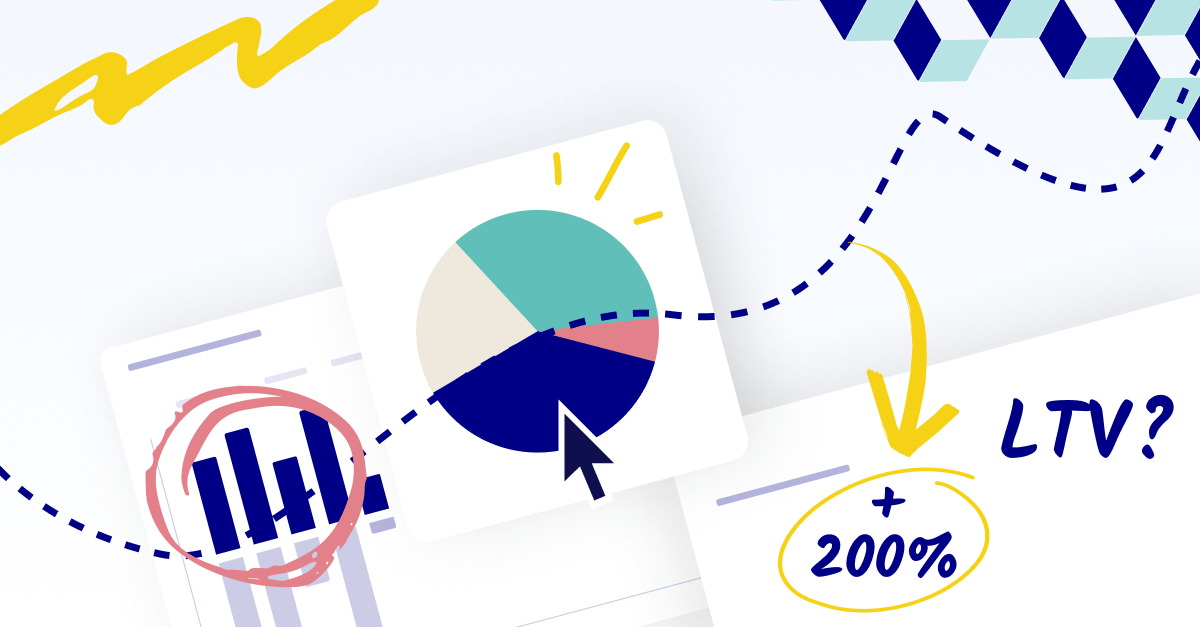What is CAC?
What is CAC?
Customer acquisition cost (CAC) is the sales and marketing costs it takes in order to acquire each customer.
You calculate it like this:
CAC = Total cost of all sales & marketing efforts / Number of new customers acquired
The result is expressed as a dollar amount and is useful for businesses hoping to understand whether their marketing efforts are paying off.
With CAC, organizations identify how much of the budget is being spent on sales and marketing and the specific revenue generated from each channel.
They then evaluate how effective those dollars are at bringing in new customers and whether incoming revenue is greater than the outgoing expense.
However, the CAC measure doesn’t work the same for each business.
How CAC is used
Customer Acquisition Cost is important in determining the return on investment (ROI) for marketing and advertising spending. Every sales and marketing expense is included in the calculation, such as:
- Sales headcount: This includes the cost of both sellers (Account Executives) and lead generation roles such as Sales Development Reps or Business Development Reps. Typically the OTE (on target earnings) is included in the calculation, which comprises of base salary, commission, and benefits.
- SEO srategies: Search engine optimization involves using site content to establish a positive rating on search engines, specifically Google. SEO creates an organic avenue for brand promotion by providing valuable content to drive prospective customers to the company’s website.
- Pay per click (PPC) campaigns: Companies pay a fee every time one of their ads is clicked. PPC campaigns are found throughout the internet and provide companies an opportunity to put their brand in front of a wider audience.
- Social media ads: Targets a specific audience using social media activity and displays ads for people that are most likely to use a company’s product or service. Using social media ads gives companies great exposure within their ideal customer base.
- Out-of-home advertising: This includes ads that consumers see outside of their homes or phones, such as billboards, posters, airport, and street furniture. Unlike digital advertising, OOH ads cannot be optimized on the fly.
CAC demonstrates the efficiency of sales and marketing spend within organizations.
Businesses use CAC by comparing the cost it takes to acquire customers with the number of new customers generated during a specific period.
This metric can help indicate whether the marketing budget is being utilized in a constructive manner and if the overall strategy needs to be adjusted. However, looking at your sales & marketing plan and costs holistically is the only way of knowing if it is truly effective.
Different types of tactics will perform different tasks for a business. Strategies like SEO are built up slowly over time. The cost of SEO may be very high in the beginning and see very little return until months or even years later. However, advertising using PPC or social media can have a more direct payoff from the beginning.
OOH advertising casts a wider net than strategies like targeted social media ads. While companies can place OOH ads where target audiences are likely to visit, they can’t analyze each passer-by and specifically call out those that are more likely to benefit from the product or service

When evaluating CAC, companies may find that only a few customers were initially gained by a large amount of SEO effort, but 200 customers were gained from social media ads.
Similarly, it can be difficult to understand how many new customers were generated from OOH advertising. It may look like SEO and OOH don’t pay off. Instead of living by those numbers and discounting the effect of those strategies, understand how each marketing effort plays into one another and what the limitations are of each.
Some sales & marketing strategies are better at building a positive reputation for a brand while others place promotional material in the metaphorical hands of a specific demographic. Each tactic has its benefits, and the combination helps build a successful marketing plan.
NOTE: Some companies choose to include expenses related to direct sales channels in this calculation while others limit it exclusively to marketing costs.
Because the leads from marketing and sales can perform differently, it may skew the CAC result.
For example, sales leads are generally passed to the team because the lead has expressed enough interest in making a purchase.
However, marketing leads may take a bit longer to warm up to the idea of buying and may need to consume more valuable content or see additional advertising.
Caution: CAC pitfalls
The CAC figure can be subjective based on the type of business that it’s used to evaluate.
It’s a great measure for companies that use a subscription-based business model, such as SaaS. CAC can translate each new customer into a dollar value in the revenue bucket because the customer will have signed up for ongoing service.
However, the CAC may not paint the full picture if a business has multiple customer values. This is because the cost it takes to acquire new customers isn’t an indicator of future revenue generated by each customer.
Consider an online retailer that sells items at a variety of prices. If a customer finds the website through a PPC campaign, the customer is added to the count and the cost of the PPC campaign to get that customer into the CAC calculation.
However, the CAC calculation fails to show how much money that customer is spending or if they’re a returning customer.
Returning customers
Gaining repeat customers is one of the best ways to build a successful business. Not only does it secure a stream of revenue, but it also saves the company money.
It’s much more cost-effective to retain existing customers than it is to acquire new customers. That’s why great organizations have robust plans for keeping in contact with their customer base.
The CAC measure lacks visibility in identifying which customers may create ongoing revenue and which are one-time-only visitors. That’s why this measure works so well for SaaS providers but not as well for other types of businesses.
Customers that visit an online retailer may purchase from the site each month but there’s no guarantee. Therefore, the cost it takes to acquire each new customer can’t be directly linked to a steady stream of revenue.
While it’s nice to know how many new customers exist each month, it’s hard to equate that to concrete business results without understanding which customers will provide repeat business
Customer spend
Likewise, the CAC metric creates a blind spot for companies that offer products or services at a wide range of price points.
As an online retailer selling various products, it’s unclear how much each customer will spend when they visit the website. Depending on the price point of products available, that customer may spend $5 or they may spend $5,000.
This creates a large variable when evaluating the CAC metric and trying to understand how much revenue is generated per customer.
On the other hand, SaaS companies sell an ongoing service that requires customers to commit to a recurring payment.
They can identify a recurring customer value (MRR/ARR) and know that the customers won through marketing efforts are committed to an ongoing monthly purchase.
Those companies have a better picture of what their marketing efforts generate monthly revenue when using CAC. As a result, the CAC metric is a more valuable figure to SaaS companies.
One metric often analyzed alongside customer acquisition cost is a customer’s lifetime value (LTV).
LTV represents the average revenue that a customer generates before they churn, offset by gross margin. LTV in SaaS is usually generated to provide a forward-looking estimate of the future.
CAC should be significantly lower than a customer's Lifetime Value (LTV) for these efforts to succeed.
The LTV metric is calculated as follows:
LTV = ARPU x LT
where ARPU is "average revenue per user (per month)" and LT is customer lifetime, or the number of months you expect a customer to stay with you before they churn.
CAC and LTV work together to form to LTV:CAC ratio.

Improving CAC
Improving the company’s CAC means the business spends less to acquire new customers. It positively impacts your bottom line and means the company is incurring less expense to produce more sales revenue. Here are some tips for improving the CAC metric:
- Evaluate your marketing efforts: Obtain a deeper understanding of which methods are helping or hurting the business, where you can optimize each channel or modify from a budget perspective
- Have more touch-points with prospective customers: Quickly engage people who visit the company website or sign up for newsletters and trials. It’s important to always have a “next step” whether it’s outreach from sales or inclusion in a retargeting program, it’s critical that your products or services stay top of mind.
- Use less expensive marketing efforts: SEO is low-cost, long term. It takes time but will lead to significant results if done well. Use blogs and a social presence to build a following and engage people often.
- Offer additional services: Showcase additional value the business brings the customer. Adding complementary services to your lineup and demonstrating how those services can help your customers achieve their goals helps generate additional streams of revenue. Seeing the value the business provides helps make buying an easier choice for customers.
Conclusion: get started with CAC
Metrics like CAC guide businesses to how they can grow and provide insights into the effectiveness of marketing plans.
While it can be a simplistic way to assign a cost to obtain each customer, it doesn’t provide all the information for every business.
Remember, CAC works well for businesses with subscription services but isn’t as valuable for companies without consistent and guaranteed recurring sales.



.png)









.png)




.png)

.png)